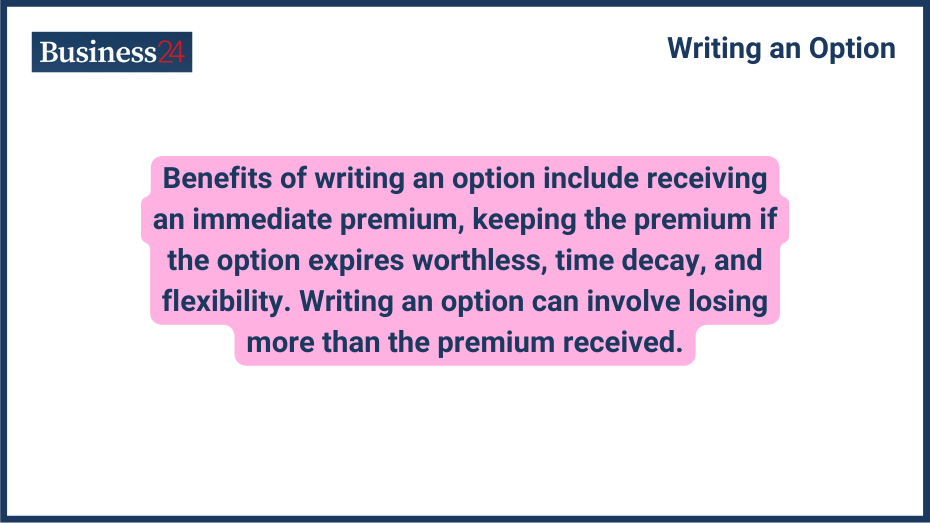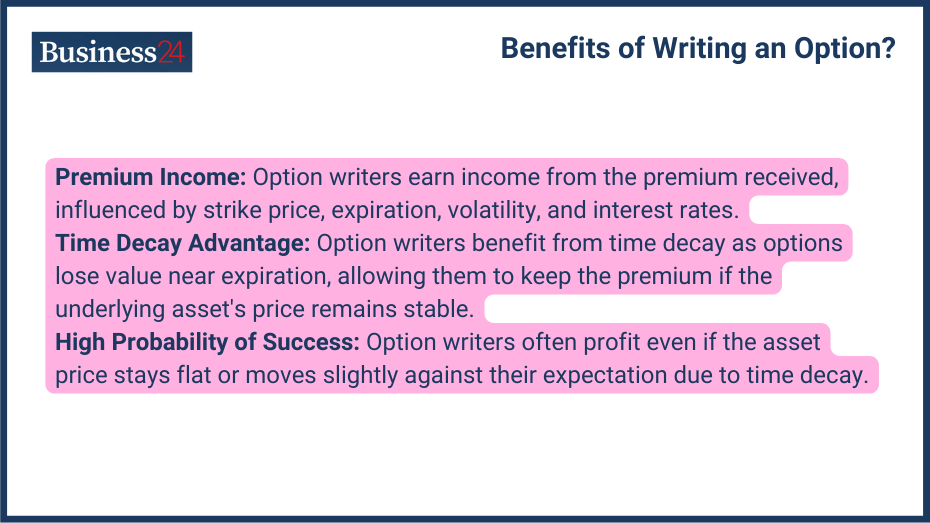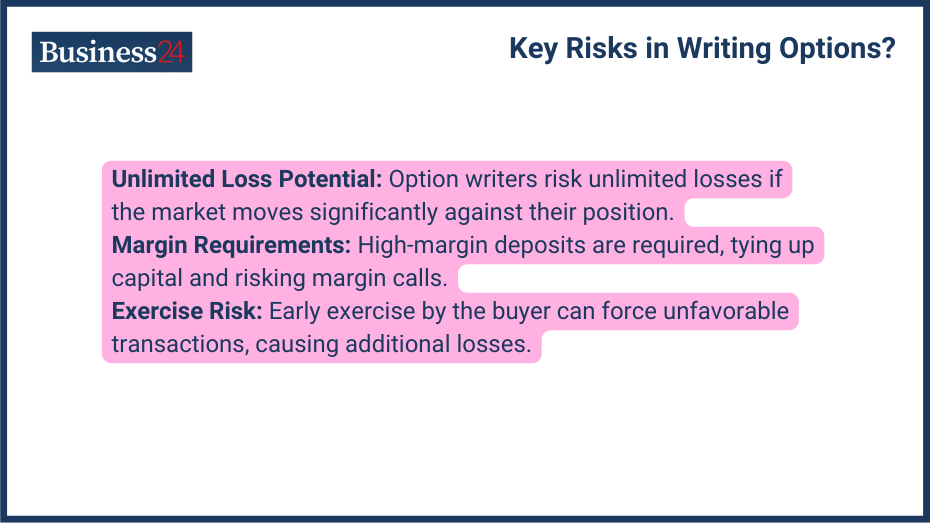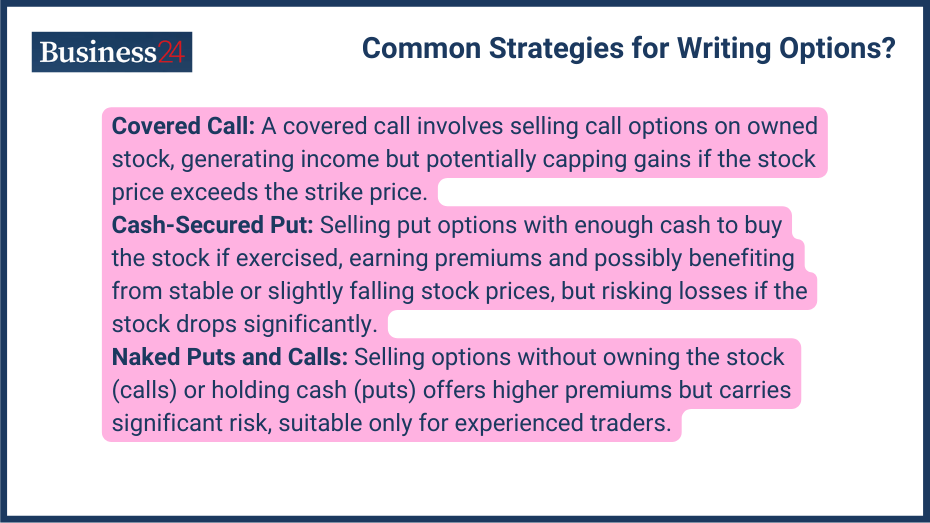
Benefits of writing an option include receiving an immediate premium, keeping the premium if the option expires worthless, time decay, and flexibility. Writing an option can involve losing more than the premium received.
There are two types of options traders: option buyers and option sellers, dont confuse it with call and put; you can buy the call as well as you can sell the call, and it is the same for put options, too. The trader who sells options, either call or put, is known as an option seller, also known as an option writer. The strategy in options trading, where you create and sell an options contract to another trader, is known as writing an option.
Unlike buying options, where you pay a premium upfront to buy the contract, as an option writer, you receive a premium from the buyer for agreeing to take on the obligation to fulfill the contract if exercised.
Writing an option is not for small traders or beginner traders, as it requires good capital and long market experience. It offers various benefits, but if you don’t know the mechanics or have less experience, you may blow up your capital.
What are the Benefits of Writing an Option?

The benefits of writing an option are:
- Premium Income: The primary benefit for an option writer is the income generated by the premium received from the option buyer. The value of the premium depends on several factors, including the strike price, time to expiration, underlying asset price volatility, and interest rates. Generally, Options with higher strike prices, longer expirations, or more volatile underlying assets have a higher premium.
- Time Decay Advantage: An option buyer has less edge, either right or wrong in general, but with a time decay advantage, option writers have more edge in the game than an option buyer. As the expiration time approaches, option contracts lose their premium to some percentages. If the price of the underlying asset doesn’t move big by the expiry date, the option loses value, and the writer keeps the entire premium received. This is good for option writers because they get profit in consolidation and even in little moves opposite to their position.
- High Probability of Success: As I mentioned above the edge above, the option writer enjoys a high probability of success because, unlike buying options where profitability depends on major price movement in the anticipated direction, writing options can be profitable even if the underlying asset price stays relatively flat or moves slightly against the writer’s expectation. As long as the price remains far enough away from the strike price by expiration, the option loses value due to time decay, and the writer retains the premium income.
What is put writing in option trading?
There are two types of contracts in option trading: call and put. You can buy and sell both the call and put option contracts. Let’s say you think TSLA is going to rise or atleast consolidate but is less probably an go down now with option contracts; you have two options: you can either buy a call option or sell a put option. Selling a put option anticipating a price rise or at least less downtrend is known as put writing.
By selling the put option, the seller or writer agrees to buy the underlying asset at a specified price (strike price) if the option is exercised by the buyer before or at the expiration date. The put writer receives a premium for taking on this obligation.
How profitable is option writing?
According to the statistics, the probability of success for the option writer is higher than for the options buyer. An example is that out of ⅔ opinion, a contract becomes worthless, which means as an option writer, your chances of winning increase to 66%.
The time component of the option increases the odds of success for option writing. However, option writing provides limited profit but unlimited loss. So, it depends upon you that if you have the expertise and the skill, you can be profitable in option writing, but you if you dont have the knowledge, it can destroy your money.
What are the Key Risks in Writing Options?

Key risks involved in writing options are:
- Unlimited Loss Potential: For an option writer, the chances of winning are high as compared to an option buyer, but there is the threat of unlimited loss, too. For uncovered or naked options, where the writer doesn’t own the underlying asset (for call options) or hold sufficient cash (for put options), the potential for losses can be big. If the market moves against the writer’s position, they have to buy or sell the underlying asset at the strike price for major losses. This risk is especially high for options with longer expirations, as there’s more time for the market to move against the writer’s expectation.
- Margin Requirements: Another important point is that option writing is hard for a trader with small capital because writing options need high-margin deposits, which can tie up a considerable amount of capital in your brokerage account. Also, this can limit your ability to make other trades. You should have cash reserved in your account in case if the market moves against your position; you might receive margin calls requiring you to deposit additional funds to maintain the minimum margin requirement.
- Exercise Risk: If the buyer exercises the option before expiration, the writer may be forced to buy or sell the underlying asset at a price that is unfavorably compared to the current market price. This can happen if the price moves in the direction that benefits the option buyer. The writer would then not only lose the premium income but also potentially experience a loss from the difference between the strike price and the current market price.
What are Common Strategies for Writing Options?

There are a lot of strategies out there, and you can make your own. Here are some of the common strategy for writing options:
- Covered Call: A covered call is a conservative strategy for investors who hold the underlying stock. The profit generated from selling the call option provides additional income, while the writer owns the stock. Here, the potential profit is limited to the premium received plus any potential increase in the stock price up to the strike price by expiration. However, if the stock price rises above the strike price and the option is exercised, the writer is obligated to sell the stock at the strike price, which could limit potential gains from a higher stock price movement.
- Cash-Secured Put: This strategy works like a covered call but on the put side. You sell a put option and keep enough cash in your account to buy the underlying asset if the option is exercised. You can earn the premium and possibly profit if the stock price stays flat or drops slightly. However, if the stock price falls well below the strike price, you’ll have to buy the stock at the strike price, which could lead to a loss. You can use this strategy to generate income, offer some downside protection for your current stock holdings, or buy shares of a desired stock at a potentially lower price.
- Naked Puts and Calls: These strategies are more aggressive because the writer sells options without owning the underlying asset for calls or holding enough cash for puts. This approach can generate higher premiums compared to covered options strategies but comes with much higher risks. If the market moves against the writer’s position, they could face substantial losses that may exceed the initial premium received. Naked option writing is typically recommended for experienced traders who understand the risks and have strategies to manage them.
How Does Writing an Option Compare to Buying Options?
Income vs. Cost
Both buying and selling options are different areas that require different expertise and knowledge, as well as different costs and profit potential. To buy an option, you have to pay the premium upfront, which a seller, if successful, will receive as a profit.
This premium represents the maximum loss you can incur from the trade. Writing options puts money in your pocket right away, while buying options takes money out of your pocket initially.
Risk Profile
Writing options can result in major or even unlimited losses, depending on the strategy used; in black swan events, option writers lose a lot of money if they are not on the right side. Buying options, on the other hand, limits the risk to the premium paid; as an option buyer, you cannot lose more than that.
Probability of Profit
As the potential for big loss is for the option seller, the probability of profit is higher for them. An option buyer is going to make money in only one condition: a good move in his direction, but if the underlying asset consolidates or move in another direction option writer is going to make the money.
What are the Practical Applications of Writing Options?
Generating Regular Income: Writing options have various practical applications for traders and investors. For traders who write options, selling options is also an income-generating activity. By employing strategies like covered calls or cash-secured puts, they can potentially earn income regardless of the direction of the underlying asset price.
Hedging Strategies: One of the best uses of writing options other than regular trading is for hedging purposes. Writing options can be used to hedge existing positions and protect against potential losses. For example, an investor who has a long position in a stock can sell covered calls to limit downside risk if the stock price declines.
Speculation: Experienced traders can use options writing to speculate on the market direction. For instance, they might write put options if they believe the underlying asset price will remain flat or decline. However, this approach involves significant risks and requires careful management to avoid substantial losses.
Educational Resources and Tools
Books and Articles
Options are a very famous trading instrument that has been traded for centuries. Great traders have made a lot of money through options and have authored many books and articles. Not all of them are good, but you can find many good books, like Option Volatility and Pricing Strategies by Sheldon Natenberg and Making Money by Selling Options by Ashish Singh.
Online Courses and Tutorials
If you want structured learning there are traders who made courses which you can opt for. Several online platforms offer structured courses and tutorials specifically designed to teach options trading strategies.
Financial Tools
Many online brokers and financial websites offer options for calculators and trading simulators. These tools allow you to practice and test different options and writing strategies before risking real capital. Utilize these tools to understand potential outcomes and develop a solid trading plan.
Is it better to write or buy options?
There is no straight answer to this question because either buying or selling an option depends on you based on your capital, risk appetite, and trading goals. So, each trader and investor can have a different answer to this question. Those with goals like income generation and big capital can go for option selling, while those with low risk and small capital can go for buying options.
Why do option writers make money?
Option writers primarily make money by collecting the premium upfront when they sell an option contract. Options also lose value over time due to time decay, which works in favor of the option writer. If the underlying asset price doesn’t experience a significant move by the expiry date, the option loses value, and the writer keeps the entire premium received.
Sometimes, option writers might have a strategy about where an asset’s price is heading. For example, if they think the price will stay the same or go down, they can write put options and make money if the price stays above the strike price by the expiration date. But it’s important to remember that this strategy can lead to big losses if the market goes the other way.
Disclaimer
eToro is a multi-asset platform which offers both investing in stocks and cryptoassets, as well as trading CFDs.
Please note that CFDs are complex instruments and come with a high risk of losing money rapidly due to leverage. 61% of retail investor accounts lose money when trading CFDs with this provider. You should consider whether you understand how CFDs work, and whether you can afford to take the high risk of losing your money
This communication is intended for information and educational purposes only and should not be considered investment advice or investment recommendation. Past performance is not an indication of future results.
Copy Trading does not amount to investment advice. The value of your investments may go up or down. Your capital is at risk.
Crypto assets are complex and carry a high risk of volatility and loss. Trading or investing in crypto assets may not be suitable for all investors. Take 2 mins to learn more
eToro USA LLC does not offer CFDs and makes no representation and assumes no liability as to the accuracy or completeness of the content of this publication, which has been prepared by our partner utilizing publicly available non-entity specific information about eToro.
